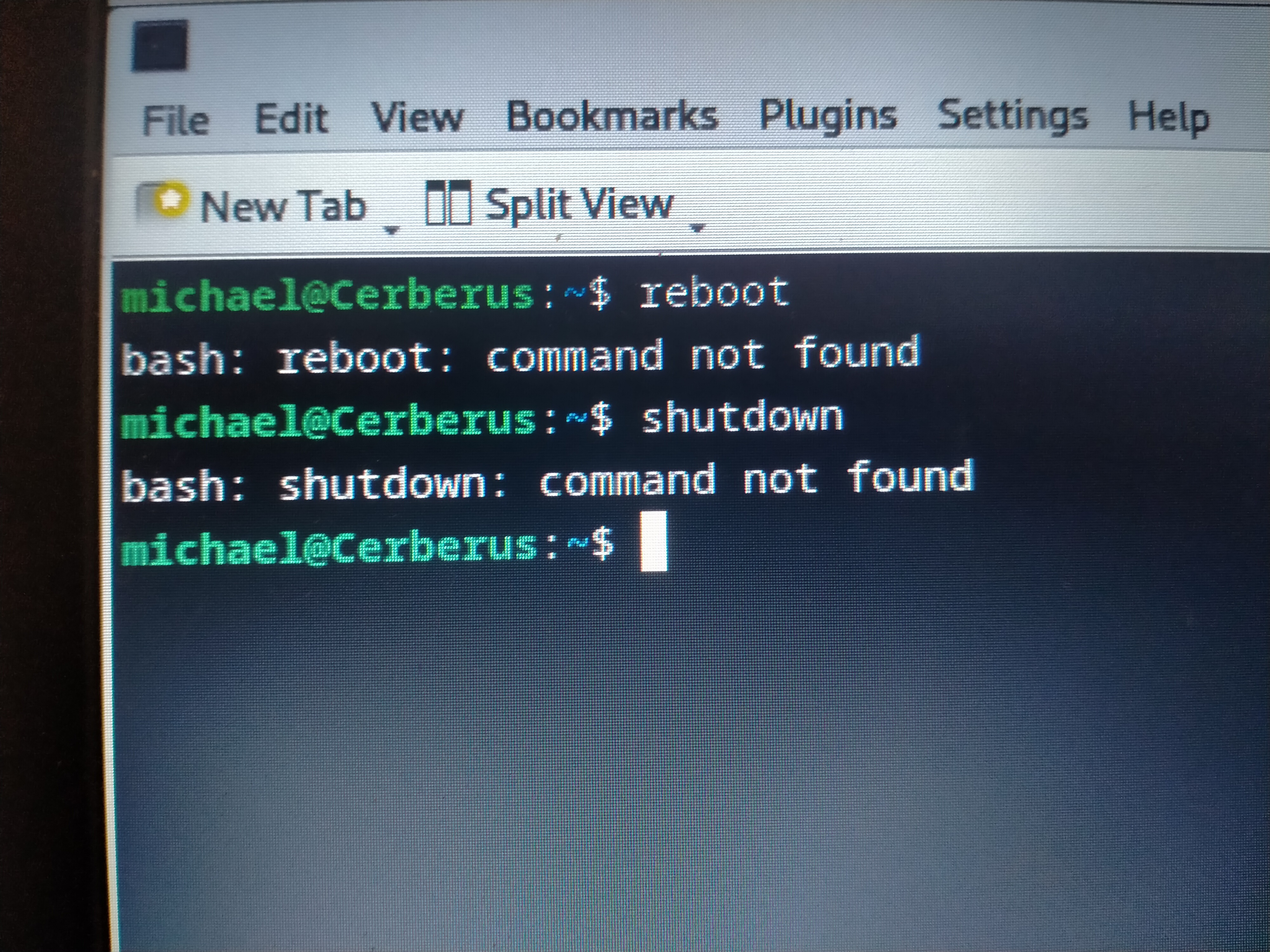As the title says, I’ve been using various flavours of Arch basically since I started with Linux. My very first Linux experience was with Ubuntu, but I quickly switched to Manjaro, then Endeavour, then plain Arch. Recently I’ve done some spring cleaning, reinstalling my OS’s. I have a pretty decent laptop that I got for school a couple years ago (Lenovo Ideapad 3/AMD). Since I’m no longer in school, I decided to do something different with it.
So, I spent Thursday evening installing Debian 12 Gnome. I have to say, so far, it has been an absolute treat to use. This is the first time I’ve given Gnome a real chance, and now I see what all the hype is about. It’s absolutely perfect for a laptop. The UI is very pleasing out of the box, the gestures work great on a trackpad, it’s just so slick in a way KDE isn’t (at least by default). The big thing though, is the peace of mind. Knowing that I’m on a fairly basic, extremely stable distro gives me confidence that I’ll never be without my computer due to a botched update if, say, I take it on a trip. I’m fine with running the risks of a rolling distro at home where I can take an afternoon to troubleshoot, but being a laptop I just need it to be bulletproof. I also love the simplicity of apt compared to pacman. Don’t get me wrong, pacman is fantastically powerful and slick once you’re used to it, but apt is nice just for the fact that everything is in plain English.
I know this is sort of off topic, I just wanted to share a bit of my experience about the switch. I don’t do much distro-hopping, so ended up being really pleasantly surprised.
Now, use these extensions (ignore the one disabled).

My setup:

Just installed Alpine linux with Gnome on my old laptop (i3-3217u with 4Gb RAM). It works really smooth, much faster than Linux Mint with Cinnamon. Aftter tweaking OpenRC run levels my boot time is only 25s (i’m using the cheapest 120Gb SSD)
If you start missing the classic taskbar and startmenu it is easily available in GNOME too:
Startmenu: ArcMenu
Taskbar: Dash to Panel
App Indicator: AppIndicator and KStatusNotifierItem SupportYknow I really thought I would want to look into that at first, but I find I really like the default config once I took an hour to get used to it. It’s different compared to what I’m used to, but it’s really smooth and fast.
I’m also a gnome shell convert. Down with the taskbar!
If it works, it works and staying close to defaults means less worries about updates breaking stuff.
I use the workspaces a whole lot more now than when I first installed GNOME but I still want my taskbar with appindicators.
Check out MX. It has some nice tools and defaults to make Debian better as a desktop distro.
Debian + Nix (home-manager) gives you a stable system and bleeding edge userland packages. It’s a perfect combo.
I tried Debian + Nix once upon a time too. Honestly flatpaks and containers did everything I needed and more, and every dev team I’ve been on already has familiarity with the container workflow.
I’m a huge fan of Debian and Nix, don’t get me wrong, but it was shy of perfect for my use case. Glad it works for you though! I’ve been using Fedora + Nix home-manager with flakes for almost two years and I don’t think I’ll ever go back
Flatpak is imperative. Nix gives me less headaches than docker. I haven’t tried distrobox.
Why Fedora? That’s what I initially started with, but it was less stable than arch on my t480, nix unstable has newer packages, and I couldn’t get nix to work with selinux.
Haha I’ve had a journey to get here, all because I have a 12th gen Framework.
Initially I got Debian Sid working but ran into power management issues with the module system. I switched over to arch and loved that for a while but frankly I was too careless and kept breaking my system. The way I use Arch it wasn’t a stable daily driver. Then I switched over to NixOS and loved it, but I bricked 3 of 4 ports with a firmware update (again me being careless). Graciously, Framework helped me fix the issue.
After all of that I decided to go with a distro that is officially supported by Framework. Between Ubuntu and Fedora I choose Fedora since they don’t have ads for Ubuntu Pro :) I also like SELinux by default and wanted to broaden my horizons
I can recommend debian testing. I’m using it on laptop and desktop for several years, always running “apt update && apt full-upgrade && apt --purge autoremove” and it never broke. It’s not officially a “rolling release” but practically it is.
I have a spare laptop that I use to play with different Linux distros and BSDs, but everything I rely on runs Debian, work and home.
I can see why. Really liking how everything feels so far. I might also use this laptop to try a flavour of BSD at some point
Same! Debian with gnome on my desktop and work laptop. Raspbian on my Pi4. Headless Debian in the cloud…
This is interesting because I’ve been thinking about switching from Debian to Arch. I’m already running Nix inside of my Debian installation to get more recent apps (I don’t like how snap interacts with the rest of the system, so I avoid it if I can).
Is there anything else on a more base OS level (like apt v pacman) that you’ve noticed is different, if you’re willing to share?
Welp, I’ve only been at it a few days, plus I’m kind of treating this system as plug and play. Meaning, on my desktop I’m happy to get my fingers into all types of config files and such, while on this laptop I intend to leave as many things default as possible. Bottom line is I haven’t looked too deep under the hood, so I can’t give too much insight on how the inner workings compare. I fully recommend giving Arch a try though. Just take things slowly and read the ArchWiki carefully.
These kind of posts confuse me. What you’re describing is not the distribution, but a vanilla GNOME experience. That can be achieved on basically any distribution with a healthy package repository. Not to mention that troubleshooting rarely involves the package manager, unless you are aware of a package that specifically breaks something. The recent pixman regression would be an example of this
In arch it’s just very easy to forget to install a specificoptional package for a subsystem that makes a feature of gnome work.
On Arch, full Gnome is packaged in a billion optional packages, and requires some manual configuration to work right just in case you wanted to run Gnome on an outdated Linux version with System-V and no PulseAudio. The defaults are for compatibility with the wacky setups Arch users like, and not so much the “it just works” approach.
On Debian, you just get all the packages an end user would reasonably expect. That’ll take up a few hundred extra megabytes and add a bunch of shortcuts you’ll probably neve use to your app selector, but it’ll work well out of the box.
You can get the Debian experience on Arch and the Arch experience on Debian, but both ways you’ll need to do a lot of messing around.
Of course, Debian is not specifically any better than alternatives like Fedora or Ubuntu in this regard, but there is a clear distinction between Arch and Debian in my experience.
I mean, a portion of my experience is switching to Gnome, yes. I also touch on multiple other aspects that are different from my regular system on a deeper level (package manager, release system, package version, etc).
This is the sort of thing that I enjoy seeing on a Saturday morning. Congrats!
Wait until you discover aptitude.
Considering that aptitude needs shortcuts it might feel like a throwback to pacman for OP.
There’s also synaptic for checking out dependencies and searching etc. which doesn’t need the user to learn shortcuts.
Where aptitude absolutely rules and saves the day is in fixing complex package conflicts… but often if your system has reached that point you might as well consider reinstall.
You can use shortcuts, or you can use the keyboard menu, or a mouse.
It also works well in case you ever get restricted to a text interface.
Aptitude has a GUI? I’ve been using it purely CLI for years.
I don’t know how I ever managed to launch it, but I think aptitude has a TUI. I mostly use it to resolve conflicts introduced by me adding external repositories and ignoring warnings, but I know there’s a way to turn it into a visual package manager that reminded me very much of the old DOS ers applications.
I agree. I did a lot of distro hopping when new to Linux to try all the desktops and have the latest apps etc. But after years of that I just wanted something stable that will be reliable and I don’t have to maintain.
I installed Linux Mint Debian Edition 6 as soon as it was released and it’s fantastic. Stable Debian base with Cinnamon on top. I couldn’t be happier.
I’ve always been confused by pacman/arch in general and always preferred apt which I find straightforward.
As one who worked in IT for years, I’m tired of micro managing systems and unnecessary complications. Linux Mint Debian Edition/Debian + apt just keeps it simple.
Timeshift is a must. Creates a system restore point in the event that an upgrade goes wrong and it really works well. I highly recommend that to all Linux users.
I also like Warpinator which is Linux Mint’s version of airdrop. Works between my android and my pc perfectly.
And there is tons of help online for Debian, unlike other distros.
I am an old hand at Linux. I started with Red Hat’s Halloween release. A few years ago I bought a Thinkpad and I slapped Pop!_OS on it and it’s been my daily driver ever since. Rock solid and stable. If you have shit to get done and don’t have time for shenanigans, Debian is hard to beat.
'94! nice!
I tried Debian a few times and never liked it… I like the Arch experience better.
I’m genuinely curious what you consider to be the “Arch experience”, other than pacman.
Install process/freedom of choice for more things (It’s more of a blank slate)
This probably does not relate too much to arch, but on Debian I found it extremely annoying to be unable to use reboot and shutdown from terminal. That was the dealbreaker for me.
Hmm, why are you not able to shutdown/reboot from the terminal? I don’t have any Debian systems running at the moment (other than Proxmox), but I’ve used Debian for over a decade and never had any issue using the terminal for power management functions (Proxmox included).
Sorry for the late reply, I also did not hav3 a Debian system running. Installed it on an old laptop I had lying around to find the error. Seems like its due to Debian changing something around debian 10. Its still possible with systemctl reboot.

Ah, gotcha. I think that’s just due to /sbin not being included in the PATH environmental variable for non-root users. Running
sudo <command>will work in those cases.
systemctl poweroffsystemctl rebootOn Debian, you have to be root or a sudoer. Those commands are there, just not in the path of regular users.
To me, the best OS will always be the one that gets out of my way as good as possible. That includes stability, maintenance, compatibility, usability and sensible defaults. I don’t want to deal with the OS when I’m trying to get stuff done or I’m looking for entertainment.
And yeah, Debian is pretty good at most of those things.
As much Gnome can be a pain to customize, out of the box I still like it for its get-out-of-the-wayness. Tap the super key, type a few chars of the name of software you want to run, hit enter and its back to being a taskbar. Very similar to tab completion in the terminal for me.
I struggle daily between wanting exactly what you describe, while also wanting to have my grubby little fingerprints on every square millimeter of my system. I think I’ve found the middleground now with a portable, “lazy” Debian system, which will mostly handle lighter use, and my dedicated Arch desktop where I go full nerd mode, experimenting and fiddling to my hearts content.
I won’t speak to the distro part of this, as this is too broad a subject, and there are too many distros I like for different use cases. Now, about Gnome, which is my favorite DE, second only to Cosmic (yes, the Gnome based one), has 1 issue since version 45 that made me jump ship to KDE 6 (which I’ve been able to set up fairly close to how I used Gnome, with some trade-offs) and that is Gnome’s choice of not allowing any Screen Shot app to work, other than their own, using the current Apple justification that “it’s for the user’s own security”, which is complete and utter bullshit. Sure, I can force run Flameshot from the terminal, but who wants to do that? I want mi screnn shot app to work from the Print-Screen key, as it should. I do miss everything else about Gnome, for sure, but I screen shot and annotate them too much to go through all the steps that are required to make it happen in Gnome 45.
This the first time I have seen someone say apt is better than pacman.
Definitely didn’t mean better. I actually do prefer pacman because of how versatile it is. Apt is more readable to me when doing simple things, but I do find it somewhat clunky in comparison if I’m doing anything complex.












